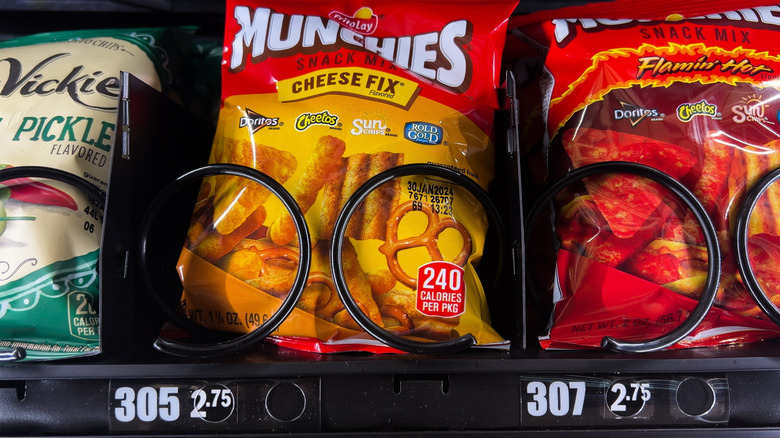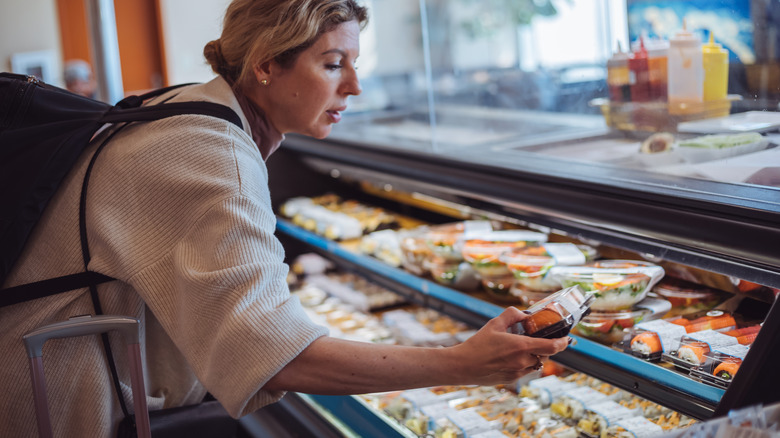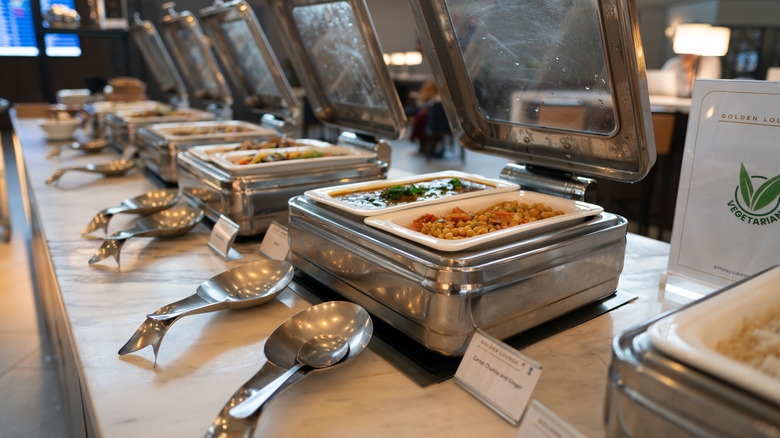Think Twice Before Buying These Foods At The Airport
Airports have a very special way of disrupting even the most disciplined eating habits. After all, between the stress of security lines, delayed flights, and the general chaos of traveling, it's easy to find yourself craving unusual foods you'd normally skip if you were anywhere else.
From the bright neon signs of fast food chains to the enticing smell of seemingly fresh-baked goods wafting through the terminals, these triggers can feel tempting when you're stuck inside with limited options. Throw in the psychological impact of thinking that your allotted "airport time" marks the unofficial start to your vacation and, suddenly, that $15 cinnamon roll that's been sitting unattended since God knows when seems completely reasonable.
However, and despite the cravings, not all airport food choices deserve your hard-earned money — or, worse, risk ruining your time off. From overpriced beers and cocktails to questionable salad bars and deli meats, there are certain airport foods out there that can leave you feeling both physically uncomfortable and financially drained. So whether you're staring down the prospect of a quick regional flight or a long-haul journey, understanding what to put off 'til later (and what to avoid altogether) can make a huge difference between soaring off in comfort or sinking into regret.
Beers and cocktails
Listen, we get it. Knowing you're about to head on vacation is definitely a reason to celebrate, and you might feel tempted to do that by knocking down a drink or three at the airport bar before you board your flight. However, the truth is a little less rosy than that. For starters, most airport drinks come with some heavily inflated prices — with some U.S. airports charging upwards of $13 for a single domestic beer. And, let's face it, nothing stings nearly as much as overpaying for booze you know costs a fraction of the price outside the airport doors. Well, except for potentially getting kicked off your flight for drinking too much.
Beyond the financial (and potentially embarrassing) impact, drinking before and during your flight can also have some pretty serious effects on your overall health. According to a 2024 study by a group of German researchers, the combination of alcohol and low cabin pressure can put extra strain on your cardiovascular system — aka, your heart. That way, when you sit back and start to doze off during your flight, your blood oxygen levels also drop significantly, which means your body has to work overtime to compensate.
Add in the dehydrating effects of both alcohol and air travel — you can lose up to half a gallon of water on a 10-hour flight — and that pre-flight drink becomes even riskier. So, if you really want to celebrate your trip, consider waiting until you reach your destination — both your wallet and your body will thank you.
Overly salty snacks and candy
Now, let's move on to those ultra-alluring airport snacks calling your name from the nearest duty-free store. While that bag of salted pretzels or handful of party-size candy bars might seem tempting, the truth is that they could both end up making your journey far less enjoyable than if you'd settled for, say, home-cut fresh fruit instead.
For starters, it's easy to think of most salty snacks like nuts and pretzels as classic travel companions, right? They're mostly portable, convenient, and mess-free. However, the high sodium content of these classics not only leads to dehydration — which, as we mentioned earlier, is already a concern in the low-humidity cabin environment — but can also cause your body to retain water, ultimately making you feel bloated at a higher altitude. Plus, many airlines now restrict nuts due to passenger allergies, so it's best to avoid them altogether.
As for their sugar-filled counterparts, the results aren't much better. Sure, the sugar rush might feel good initially — but giving into that king-size chocolate bar or gummy worms craving is basically setting yourself up for an energy crash mid-flight. Which can make for a miserable and uncomfortable journey — especially if you're about to board an ultra-long flight where what you eat matters.
Sushi
While beers and snacks might be more of a preference than a strict "do-not-buy," knowing what airport food to eat or pass on also has to do with overall food safety. And while we definitely understand wanting to grab a quick bite before your flight, there's one food we definitely recommend you avoid at airports: sushi.
The main issue with airport sushi comes down to proper storage and handling. Unlike certain sushi restaurants where the fish is fresh and handled by experienced chefs, airport sushi is typically mass-produced and, realistically speaking, probably doesn't meet the same rigorous standards you might be used to. In fact, the Centers for Disease Control and Prevention (CDC) specifically warns against consuming raw or undercooked seafood because there's a much higher risk of bacterial contamination. And, really, the last thing you want is to be stuck on a plane dealing with food poisoning.
Beyond the safety concerns, there's also the question of quality and plain ol' common sense. After all, ordering raw fish at a landlocked airport terminal isn't exactly a recipe for the freshest meal. Plus, airports in general are pretty notorious for having some of the worst food out there. Why would you waste your money on subpar sushi when you can just wait a couple of hours to kill that craving when you're outside the limits of airport dining?
Salad bars and buffets
If you're already rushing to catch your flight, grabbing a pre-packaged salad or hitting the airport buffet might seem like the most convenient and healthy choice. However, don't let those fresh appearances fool you. Contrary to what you might think, these self-serve options generally come with their own set of food safety concerns that might make you want to reconsider.
For starters, pre-made salads — which generally sit unattended in display cases for hours at inconsistent temperatures — pose particular risks including bacterial growth and contamination. Per the CDC, leafy greens can harbor harmful bacteria that washing alone won't remove. Even worse, these germs can actually get inside the leaves themselves — making them almost impossible to clean completely. The same goes for the self-serve salad bar. While the ingredients might look fresh and appetizing under the beaming display lights, foods like chicken, eggs, sprouts, and cheeses are particularly susceptible to bacterial growth due to their high moisture content and neutral pH. Plus, it's also worth noting that countless travelers have been there before you, handling the same serving utensils, and getting a little too close for comfort with that bowl of lettuce you're about to scoop.
As for hot buffet items, these can be even riskier. In most cases, airport buffets often struggle to maintain proper food temperatures throughout the day. This, in turn, allows foods to enter the so-called "danger zone" (between 40 and 140 degrees Fahrenheit) where bacteria thrives. The usual suspects include things like shellfish, potato salad, coleslaw, foods made with unpasteurized dairy, and rare meats. Combined with the constant stream of people using shared serving utensils, you're better off finding something made to order, even if it takes a few extra minutes of your time.
Deli meats and sandwiches
Unfortunately for hungry travelers, not even that grab-and-go sandwich is safe from the potential threat of bacteria and foodborne illness. Although it might seem like a safer choice compared to sushi or salad bars, there are still plenty of risks associated with pre-made sandwiches that haven't been properly stored.
Similarly to the other foods, the CDC specifically warns about the dangers of packaged lunch meats, which can harbor harmful listeria bacteria — a serious infection-causing bacteria that can lead to fever, muscle aches, and even more severe symptoms. This is even more concerning at airport vendors, where temperature control and storage time aren't always ideal. So, while a fresh-made sandwich from a reputable deli might be just fine, those pre-packaged options sitting in the fridge aren't always that lucky. Prep-wise, you should always try to go for deli meats that have been heated to an internal temperature of 165 degrees Fahrenheit — something you definitely won't find in that cold turkey sub that's been sitting there since morning.
Beyond that, most airport sandwiches tend to be loaded with sodium-heavy processed meats and condiments. Combined with the dehydrating effects of air travel, this can leave you feeling uncomfortable during your flight. All of which goes to say, if you really need a sandwich fix, consider packing your own from home (Yes, you can bring your own sandwich through TSA.) or waiting until you reach your destination.





